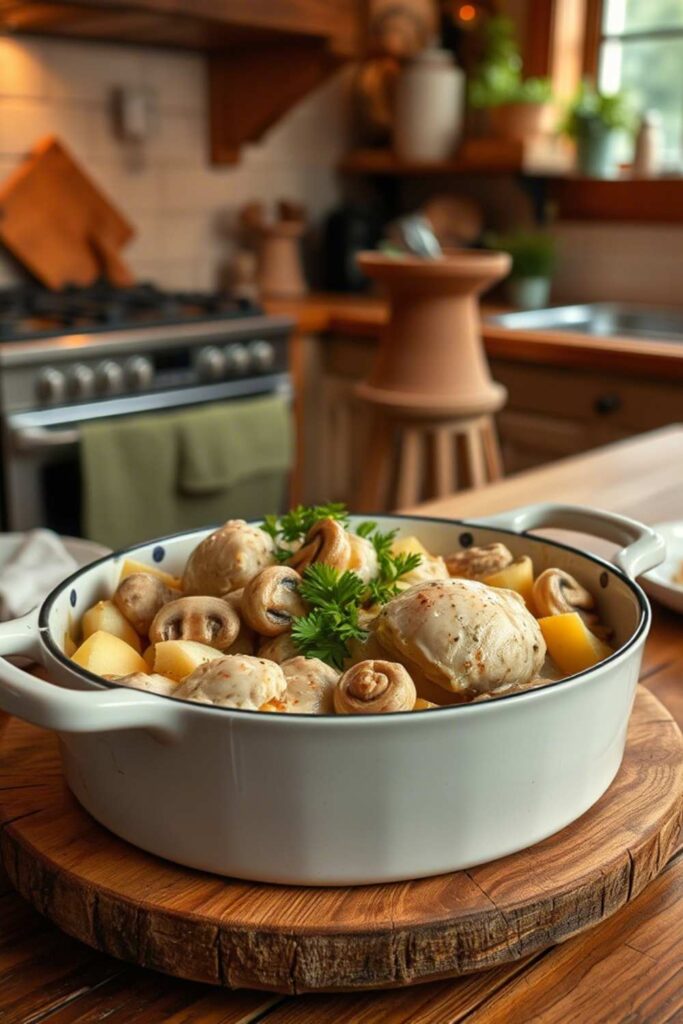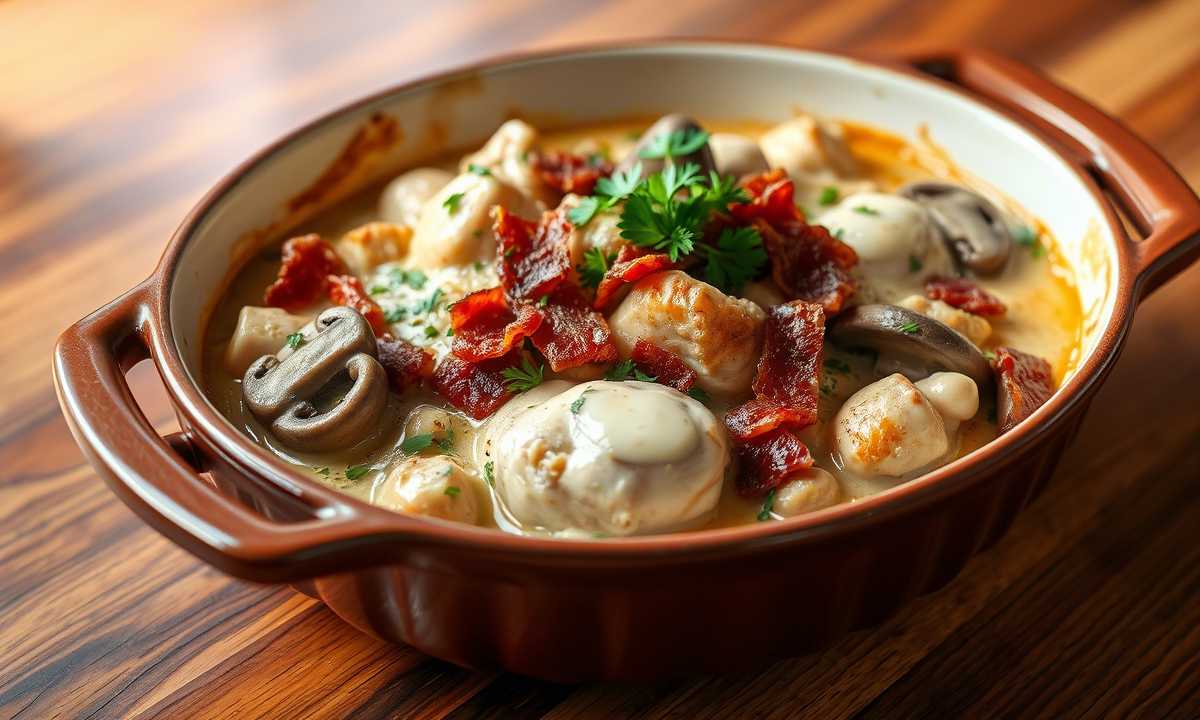The first time I made Poulet à la Normande, it was dead winter in my tiny Paris apartment. The cold snuck in through the floorboards, and the oven’s warmth was the only comfort. I wasn’t trying to impress anyone—just hungry and curious. One bite of that rich, creamy apple-brandy sauce over tender chicken, and I knew: this was more than food. This was a story.
This French chicken casserole—native to Normandy—is a luxurious yet humble dish. It captures the essence of French countryside cooking: apples from the orchards, cream from local cows, and a good glug of Calvados. Simple ingredients, layered technique, and one deeply comforting result.
What makes this casserole so special? It’s not just the flavor. It’s the way each step coaxes out more character—searing the chicken until golden, deglazing with brandy, folding in cider, thyme, and cream. The apples soften like butter, the sauce clings just right, and the chicken? Fork-tender but still juicy. This isn’t fast food. It’s slow magic.
Ingredients & Substitutions
Below is what you’ll need for the classic version. Don’t worry—I’ll walk you through smart swaps too.
- 4 bone-in, skin-on chicken thighs (you can also use a mix of thighs and drumsticks)
- 2 tablespoons unsalted butter
- 1 tablespoon neutral oil (like grapeseed or canola)
- 2 shallots, finely sliced (or 1 small onion, but shallots add finesse)
- 2 garlic cloves, minced
- 3 medium apples (firm ones—Granny Smith, Braeburn, or Honeycrisp)
- 150 ml Calvados (or good-quality apple brandy; apple juice if avoiding alcohol)
- 300 ml dry apple cider (don’t confuse this with sweet cider or apple juice)
- 200 ml crème fraîche (or heavy cream with a spoonful of yogurt)
- 1 teaspoon Dijon mustard
- Fresh thyme sprigs (or ½ tsp dried thyme, but fresh gives perfume)
- Salt & pepper, to taste

Substitutions? Sure.
- No Calvados? Cognac works. So does dry white wine + a splash of apple juice.
- No crème fraîche? Use sour cream—but watch for curdling. Stir it in off-heat.
- Vegetarian? Swap chicken for firm mushrooms like oyster or portobello, and use veggie broth.
Pro tip: Use bone-in chicken. It flavors the sauce like nothing else. Boneless will cook too fast and dry out if you’re not careful.
Step-by-Step Instructions
1. Brown the Chicken—No Skipping
Heat oil and butter in a Dutch oven over medium-high. Season the chicken with salt and pepper. Then sear it skin-side down. Don’t move it too soon—let it build that crust.
Turn it only once golden. You want crisp, browned skin. That brown bit at the bottom? That’s flavor. Don’t lose it.
Set the browned chicken aside.
2. Build the Base
Lower the heat a tad. Add shallots and garlic to the same pan. Cook until soft, about 3 minutes. Add the sliced apples and sauté until lightly caramelized. They’ll soak up the chicken fat and butter. It’s ridiculous.
Now splash in the Calvados. It’ll hiss and bubble like it’s angry, but that’s what you want. Scrape up all the browned bits stuck to the pot. That’s pure gold right there.
Let the alcohol cook off for 1–2 minutes, then stir in the cider. Simmer for another 5 minutes.
3. Add Cream, Herbs & Return the Chicken
Stir in the crème fraîche and mustard until smooth. Throw in thyme sprigs. Nestle the chicken back in, skin-side up.
Cover partially. Simmer gently for 35–45 minutes. You want the sauce to reduce and thicken, not boil into oblivion.
Want it extra creamy? Add a splash more cream toward the end.
4. Finishing Touches
When the chicken is tender and almost falling off the bone, it’s done. Taste the sauce. Need salt? A touch more mustard? A whisper of pepper?
Pull out the thyme stems (they’ve done their job). Let the casserole sit for 5 minutes. It thickens beautifully as it rests.

Cooking Techniques & Science
Let’s get nerdy, shall we?
Why sear first? Searing chicken isn’t just for looks. It creates Maillard browning, developing deep, roasted flavor. You’re also rendering fat from the skin, which flavors the apples and shallots beautifully.
Deglazing with Calvados unlocks the fond—the sticky brown crust at the bottom. Alcohol dissolves these tasty bits better than water or broth.
Apples in a savory dish? Normandy cuisine often mixes sweet and savory. Apples cut through the richness of the cream and chicken. It’s a balance, not dessert.
Cream last, not first. Heating dairy too early can cause it to split. Adding it after the cider reduces keeps it silky.
Dutch oven > regular pot. Heavy-bottomed cast iron distributes heat evenly. It keeps the sauce from catching and burning during long simmers.
Serving & Pairing Suggestions
Serve straight from the pot—Normandy style. But if you’re going fancy, here’s how to elevate it.
- Serve with: Buttery mashed potatoes, crusty baguette, or soft egg noodles.
- Garnish with: A few thyme leaves, a swirl of cream, and maybe apple matchsticks for contrast.
- Pair with wine: A dry French cider, Chardonnay, or even a chilled Chenin Blanc. You want acidity to cut the richness.
Feeling rustic? Tear off a hunk of bread, scoop it right into the sauce. It’s not rude—it’s real.
Conclusion
This isn’t fast food. It’s not even fast French food. But French Chicken Casserole à la Normande is a dish worth waiting for. Each step builds flavor. Each bite tells a story of orchard trees, wooden tables, and cold nights warmed by cream and cider.
Remember:
- Sear that chicken like you mean it.
- Let the apples go golden before drowning them in cider.
- Don’t rush the sauce—it knows what it’s doing.
And if something goes wrong? It’s still chicken, apples, and cream. You’re not failing, you’re learning.
FAQs
What kind of apples work best in this recipe?
Firm apples like Granny Smith or Braeburn hold their shape during cooking and don’t turn to mush. Avoid Red Delicious—they’re too soft and sweet.
Can I make this dish ahead of time?
Absolutely. In fact, it tastes even better the next day. Just reheat gently over low heat so the cream doesn’t split.
Is Calvados necessary?
Not strictly, but it’s traditional and adds depth. If unavailable, use apple brandy, Cognac, or dry white wine + a splash of apple juice.
What if I don’t have crème fraîche?
Use heavy cream with a spoonful of plain yogurt or sour cream. Add it off heat to prevent curdling.
Can I freeze this casserole?
Not recommended. Cream-based sauces can separate when frozen. Instead, store in the fridge for up to 3 days.
Final tip: If the sauce looks thin, simmer it uncovered for a few minutes. If it’s too thick, a splash of cider brings it back to life. Like most good things in cooking, balance is everything.
This dish isn’t just dinner. It’s a cozy French afternoon tucked into a pot.








